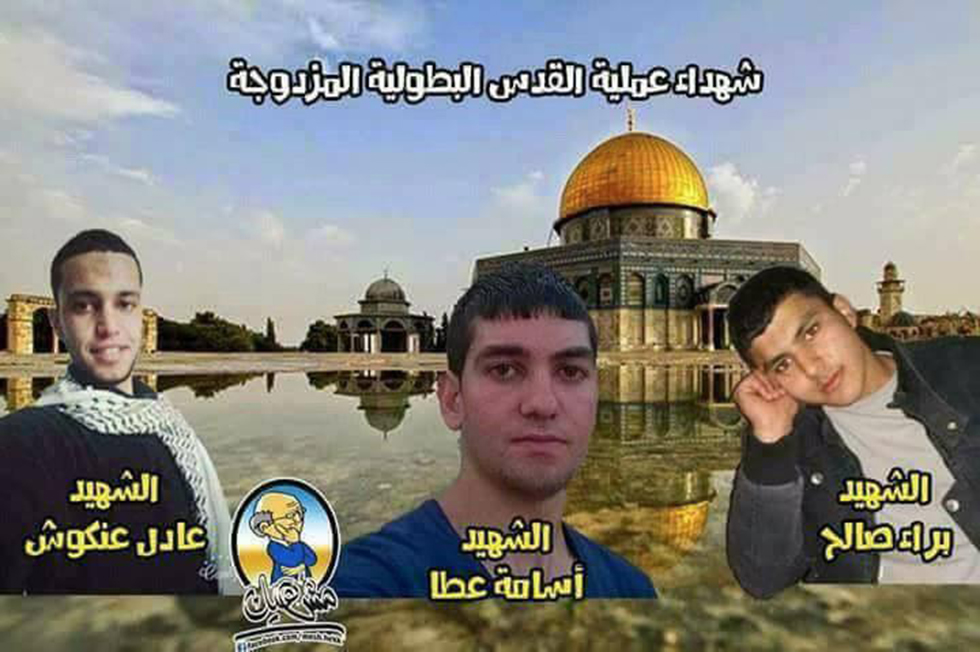
The terrorists' last photo
The wave of terror surges on
Analysis: ISIS and Hamas contended for responsibility for the Friday attack in Jerusalem, but all the signs show that this is a spontaneous local terrorist cell; Israel responds in a measured manner with the main goal being to isolate the terrorists and their families and not to harm the population; Maybe not a full-blown intifada, but Israel is still suffering from a wave of terror.
According to all the findings of the investigation to date, there is growing certainty that the attack on Friday evening in Jerusalem was carried out by what is known as a locally organized terrorist cell, or a "local cell" for short.
Although ISIS took direct responsibility and Hamas took implicit responsibility, it is already clear, according to the findings at the scene, the manner and timing of the attack and the identities of the terrorists, that these are three young men, who have no security felonies on record, organized and acted on their own.
The terrorists bought their weapons themselves while one of them was active in distributing nationalistic and religious content on the Internet.
They worked in East Jerusalem and minutes before breaking the fast of Ramadan, while many Muslims flock to the street to feast, it was easy for them to mix with the crowd without Israeli security forces noticing them.
They organized spontaneously and made amateurish preparations.
This behavior characterizes most of the attempted attacks in the past year and a half. It also shows that the wave of terror that began in Rosh Hashanah in 2015 has not yet ended.
The quiet we have witnessed in recent months does not stem from the fact that the young Palestinians in the West Bank have given up their terroristic ambitions, but because of the IDF and Shin Bet's security operations— such as the raids on arms manufacturing workshops and self-manufactured weapons warehouses in the West Bank, as well as their cooperation with Palestinian security forces to foil the plans of the more extremist citizens of the West Bank.
The jam of one of the terrorists' guns, due to which more casualties were avoided, can certainly be attributed to the fact that the quality of weapons made in the West Bank is decreasing as a result of the intensive activity of the security forces to destroy the production infrastructure.
In 2016 there were 117 local cells of the kind that operated in Jerusalem on Friday, which were thwarted by intelligence activity and cooperation with the Palestinian security services.
The implication is clear: The policy that the IDF and Shin Bet recommended in Judea and Samaria did not succeed in ending the wave of terror, but rather in preventing its escalation to a full-blown intifada.
The counterterrorism efforts minimize the damage, but spontaneous Palestinian terrorism still exists.
This type of terrorism is divided into three kinds.
The first is Individual terror, where isolated individuals act on their own initiative or impulse, for various reasons, such as vengeance, religious fervor, and family and social problems.
The second is local cells. Young people from the same family or community, who decide to work together, buy weapons, make simple intelligence preparations and then act, just like the three on Friday.
The third is organized groups who operate under orders, supported and financed by terror organizations such as Hamas, ISIS and others. Out of the three, these groups are the most dangerous and security forces devote considerable resources and efforts to thwart their activities. They are skilled, have access to explosives and prepare an escape plan for after the attack.
It is quite clear, for example, that Hamas is trying to carry out an attack or several attacks in Judea and Samaria in retaliation for the assassination of senior Hamas commander Mazan Fukha, an assassination which Hamas blames Israel for. Apparently, Hamas is trying to carry out a large-scale and flashy attack, but in the meantime, the Shin Bet and the IDF remain successful in thwarting their plans.
Both Hamas and ISIS took responsibility for the attack, which was relatively unsuccessful. However, it seems that none of the organizations has a direct connection to the attack, which is motivated by religious fanaticism during the Ramadan fast, and by the general despair of young Palestinians in Judea and Samaria, many of whom are unemployed and find it difficult to earn a living.
The Israeli government's response to the attack is interesting. It canceled some of the easing restrictions imposed by the Coordinator of Government Activities in the Territories on the occasion of the Ramadan fast and prohibited the families of the terrorists from entering and working in Israel. However, worshipers will still be able to continue the Ramadan prayers on the Temple Mount.
The Israeli response is measured and is a continuation of the policy in which the security forces try not to harm the fabric of life of most Palestinian citizens in Judea and Samaria. The goal is to isolate the terrorists from the general population, enabling those who are not dangerous to be able to continue their routine. This policy has proven itself in the past two years and will apparently continue despite the attacks.
(Translated & edited by Lior Mor)













